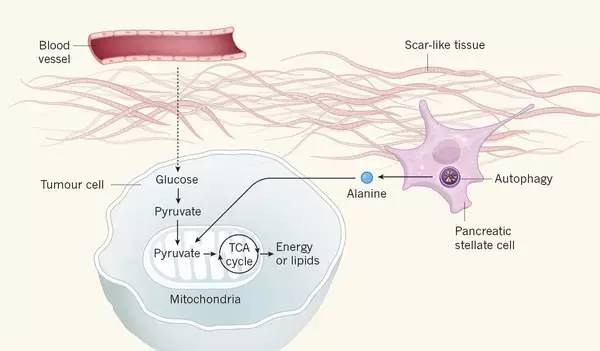Pancreatic cancer "damaging others" or becoming a new target for treatment August 18, 2016 Source: WuXi PharmaTech Pancreatic cancer is a highly heterogeneous malignancy that is one of the most deadly types of cancer, with a five-year survival rate of less than 5%. Because it is not easy to be diagnosed early, more than 85% of patients with pancreatic cancer are diagnosed in the late stage, and at this time there is no cure. The high invasiveness of pancreatic cancer is related to the composition of its tumor: pancreatic cancer tumors are rich in interstitial and less blood vessels, and their interstitial components usually account for nearly 90% of the tumor volume, and maintain a close signal relationship with cancer cells. It is critical to the development of cancer. On the other hand, because of this feature, if pancreatic cancer cells want to survive, they must obtain enough nutrients in the case of less blood supply. So, what kind of survival "secrets" do pancreatic cancer cells have? Recently, scientists from institutions such as Harvard University and the University of Michigan gave the answer. They found that pancreatic cancer cells can survive this way because they have been doing what they are doing to “destroy people and benefit†– by sending messages to the stellate cells in the pancreas, “destroying†the latter to break it down. The cellular components are then supplied to the cancer cells for feeding. This achievement was published in the recent issue of Nature. ▲ stellate cells deliver nutrients to pancreatic cancer cells It turns out that after being "misleaded" by pancreatic cancer cells, stellate cells initiate autophagy, a process that uses lysosomes to recover damaged or aging components of the cells for reuse. The amino acids are secreted outside the cell. At this time, pancreatic cancer cells begin to "drink" the two non-essential amino acids, alanine and aspartic acid, for their own use. Among them, alanine is converted to pyruvic acid by transaminase to enter the tricarboxylic acid (TCA) cycle, providing energy for cancer cells and synthesizing other nutrients required. In this way, the mitochondria of pancreatic cancer cells can operate at high speed to meet their survival and expansion needs. However, this survival trick of pancreatic cancer cells can sometimes become a "life gate." When the researchers blocked the autophagy process of stellate cells in mice by gene technology, the growth of pancreatic cancer tumors was significantly inhibited. "Our research shows that pancreatic cancer cells have an unusual form of energy metabolism and take a more efficient approach to energy harvesting than many other types of cancer cells," said the author of the article, Professor Alec Kimmelman of Harvard University. Revealing a new way of interacting between tumors and stellate cells may provide new insights into the development of pancreatic cancer therapies, which are the most flexible modes of metabolism that interfere with pancreatic cancer cells. Home Safe ,Home Safe Box,Home Safe Box Fireproof,Fireproof Waterproofhome Safe Box Ningbo Zhaomu Electronic Commerce Co., Ltd. , https://www.bofonhome.com